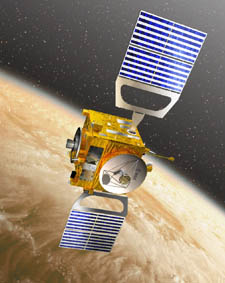Sometimes an important finding comes about by painstakingly combing through observations for subtle clues. Sometimes it's a matter of luck, just being at the right place at the right time. And sometimes, as I learned yesterday at a meeting of 850 planetary scientists, it's both.

Artist's impression of Venus Express in orbit.
European Space Agency
The story begins in mid-2006, not long after a European spacecraft called Venus Express reached its destination and started to analyze the planet's dense, cloud-choked atmosphere. One of the experiments watches the Sun rise and set through the uppermost layers of air, looking for atoms and molecules that create unique infrared absorptions in the arriving sunlight.
Jean-Loup Bertaux, a veteran aeronomist at the French agency CNRS, leads the international team that built the instrument. While looking for the spectral signature of hydrogen chloride (HCl), he stumbled across a complex "fence" of absorptions near 3.3 microns. No known molecule matched what Venus Express had found, and Bertaux spent another six frustrating months trying to learn its identity. He tentatively concluded that the mystery molecule was some kind of strange new organic compound. That, in itself, would be an astounding — and controversial — revelation.
Meanwhile, on the other side of the Atlantic, NASA-Goddard Geronimo Villanueva and Michael Mumma were wrestling with some new infrared spectra of Mars they'd taken using two telescopes on Mauna Kea in Hawaii. They were on the trail of methane (CH4), a molecule that shouldn't exist in the Martian atmosphere. To exist at all, it must be produced by some process on the surface (most logically by microbial life). The first detection of Martian methane, announced a few years ago, was met with skepticism and controversy.
In going through their spectra, Villanueva, Mumma, and four colleagues came across the same complex nest of absorption lines near 3 microns. As Bertaux had done, they tried to find a spectral match match in a database of spectra for thousands of different compounds, without success. They deduced that it must be a peculiar form of carbon dioxide (CO2) that included an atom of the isotope oxygen-18 instead of the far more common oxygen-16.
Mumma contacted Bertaux. From my chats with both of them, the conversation went something like this:
"Hey, Jean-Loup, we've got a little puzzle here in our Mars spectra. Do you see anything funny in your Venus Express data at around 2982 wavenumbers?"
"Sacre bleu! I sure do, Mike! I've been stumped by this for months. I figured it must be some kind of organic — I'd even started writing up a paper about it."
The mystery was solved. And even though Bertaux's team won't be able to claim that organic matter is raining down on Venus, it's a key discovery nonetheless. This variant of CO2 is rare in the Venusian atmosphere, occurring only once in every 250 molecules. But it absorbs infrared energy at wavelengths that normal carbon dioxide does not and thus plays a small but important role in creating the "greenhouse effect" that keeps the planet's surface at an insanely hot 900°F (480°C).
 0
0
Comments
You must be logged in to post a comment.